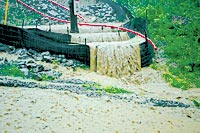According to Asheville’s federal storm-water permit, the city was supposed to adopt a revised Stormwater and Erosion Control Ordinance by July 1. Seven weeks later, the revamped set of rules was still making its way through the legislative process; at press time, it was scheduled to come before City Council on Aug. 21. Meanwhile, property owners, environmentalists, developers and other stakeholders took turns sounding off at the podium during three public-information meetings (held Aug. 9, 14 and 15).

Buffer zones emerged as the most contentious issue. An aquatic buffer is a strip of land on either side of a stream or wetland in which development is restricted in order to protect the waterway from becoming degraded. The city’s previous ordinance required a 30-foot buffer—the state minimum—but the new law would bump that number up to 50 feet.
“We had a consultant group help us with the technical aspect of the ordinance, and a lot of their research suggested much wider buffers,” explains Stormwater Services Manager Chad Pierce. “That’s where we got that additional 20 feet. A lot of it has to do with the steeper terrain in our area.”
But the public reaction was lukewarm at best. A few commended the city for trying to “hold developers’ feet to the fire” by cracking down on storm-water runoff escaping from large-scale construction sites. At the same time, many individual landowners voiced concern that the new rules amounted to unfair restrictions on their property rights.
“As I see it, there are two separate problems,” Asheville resident Walter Plaue said at one of the meetings. “One is the dirt caused by a developer not containing their silt. But there is another issue: The person who has a little house and a little stream running through their property … is getting caught up and penalized for the bad actions of a few developers.”
Pierce, however, believes that many speakers’ concerns about the city taking their property stem from a misconception. “The rule only applies to new development and redevelopment … after the ordinance is passed,” he explains.
Meanwhile, environmental groups looking to protect water quality seemed to think that even the extended buffer is barely adequate.
“Although there are some aspects of this ordinance that I was happy to see go above and beyond the minimum state requirements, there is still a lot of room for improvement in the language,” asserts Gracia O’Neill of Clean Water for North Carolina. “Then, of course, there is the issue of whether the improved measures—and those that should be added—will ever be adequately enforced.”
French Broad Riverkeeper Hartwell Carson takes a similar tack. “Sedimentation is the No. 1 polluter in Asheville and the French Broad watershed,” he says. “Fifty feet is the absolute bare minimum that is needed to protect private and public property and the rivers.”
In response to a question at the Aug. 9 public meeting, city staff issued a Q&A sheet that says, in part: “All the research on buffer widths suggests that to have a dramatic impact on water quality, the ideal buffer width should be between 100 and 300 feet. The proposed width is the minimum to accomplish these goals.”
People also expressed general uneasiness about the complexity and technical nature of the ordinance, coupled with concern that the public hadn’t been adequately notified about the rule change. “One size of this ordinance does not fit all,” one woman commented, “and it is causing tremendous rage.”
The stormy debate seems likely to erupt again when the ordinance goes before Council for a final vote.



Before you comment
The comments section is here to provide a platform for civil dialogue on the issues we face together as a local community. Xpress is committed to offering this platform for all voices, but when the tone of the discussion gets nasty or strays off topic, we believe many people choose not to participate. Xpress editors are determined to moderate comments to ensure a constructive interchange is maintained. All comments judged not to be in keeping with the spirit of civil discourse will be removed and repeat violators will be banned. See here for our terms of service. Thank you for being part of this effort to promote respectful discussion.